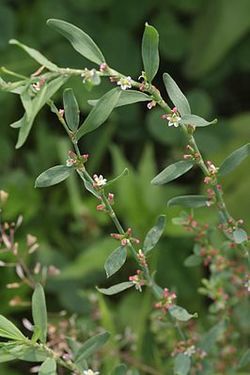Common Knotgrass
Other Names : Polygonum aviculare, prostrate knotweed, birdweed, pigweed, lowgrass, Gewoon varkensgras, Vogelknöterich, Renouée des oiseaux,Chinese Pinyin: Bian Xu, Simplified Chinese: 匾蓄, 扁蓄, 扁竹, 扁辨, 扁蔓, 粉节草, 道生草, 竹叶草
is a species of annual flowering and herbaceous plant in genus Polygonum (Polygonaceae family). Found in fields and wasteland (from between 10 to 4,200 metres in elevation) in many countries in temperate regions, the plant can grow up to 40 cm tall. The aerial parts of knotgrass are used in herbal medicine. The plant is collected during the summer months when it is in bloom and then dried at 45 ° C.
Contents
Special Precautions of Common Knotgrass
- Knotgrass is considered a safe herb to use with few warnings and side effect.
- Excessive use of the herb should be avoided during pregnancy as it may have abortifacient properties.
- No contraindications, side effects or interactions with conventional medicine or other medicinal herbs have been reported.
Constituents
Silicic acid (partly also water-soluble), tannins (gallotannins and catechols), flavonoids, especially avicularin, phenolic acids and mucilage, flavonoid glycosides (hyperin, quercitrin and avicularin). In addition, the herb contains mucins, tannins, traces of an essential oil, vitamin C and other substances.
Health Benefits and Uses of Common Knotgrass
- The whole plant of Polygonum aviculare is used as antipyretic, detoxicant, diuretic and discutient in traditional Chinese medicine (CTM) and widely adopted in treating diseases and health problems including intestinal worms and haemorrhoids. The content of tannins is presumably the reason why the herb has astringent and styptic properties, while the flavonoid glycosides are the reason for its diuretic properties.
- In Chinese herbal medicine, the herb has been used for over 2000 years. There it has mostly been used to expel intestinal worms in children, for the treatment of diarrhea and dysentery, as a remedy for jaundice and gonorrhea, and as a diuretic herb, especially in cases when urination is painful. Polygonum aviculare is considered to have bitter, neutral and nontoxic properties and to be associated with the large intestine and spleen meridians. (TCM)
- Skin Health : Juice of Polygonum aviculare is taken to ease swelling of hemorrhoids. Smashed Polygonum aviculare is used externally to treat malignant sores. The crushed leaves or a strong decoction of the plant can be used as a styptic and wound healing agent
- Jaundice in Adults - Liver and Galbladder Disorders : Medicated soup with Polygonum aviculare and fermented soya beans is taken orally to treat jaundice.
- Intestinal Worms : A decoction of Polygonum aviculare is taken on an empty stomach to treat intestinal worms.
- Knotgrass is usually used in conjunction with other medicinal herbs in teas intended as a treatment for bronchitis and other respiratory ailments.
- Extracts of the herb are often added to standard herbal formulas used to treat coughs and to increase the production of urine.
- The seeds of knotgrass are very similar to the seeds of buckwheat (Fagopyrum esculentum) and just as starchy.
- The astringent properties attributed to the tannin content are used for rinsing and gargling for inflammation of the mouth and throat, as well as external applications against blemishes and wound treatment. The herb has been used to treat mild respiratory tract infections and inflammatory conditions in the mouth and throat. A clinical study showed that the use of a mouthwash containing extracts of the herb for two weeks had an anti-inflammatory effect on gum inflammation.
- In the past, the sap of knotgrass was used as a styptic agent and was especially recommended for nosebleeds. Some herbalists still prescribe a tea made from the dried herb as a topical astringent for bleeding hemorrhoids.
- Knotgrass has also been shown have antimicrobial properties and that it could be useful as a treatment for fungal infections.
- Internally the herb is used in tea form as a remedy for many ailments associated with gastrointestinal system, such as diarrhea, ulcerative colitis and hemorrhoids and also for diseases related to the urinary tract such as cystitis, renal gravel and kidney stones that do not block the ureter.
- In its monograph Polygonum aviculare, the Committee for Herbal Medicinal Products (HMPC) of the European Medicines Agency (EMA) confirms the traditional use in the indications cold (tea infusion), mild mouth and throat (gargle tea) and bladder irrigation Complaints (decoction).
- Breast Cancer : Organic compounds such as phenolics that are found in Polygonum avicularis at high amounts exert various biological effects including antioxidant and anti tumor activities. Results showed that Polygonum avicular induced cytotoxicity in MCF-7 cell line at concentrations higher than 300 ng/µl and this was confirmed by the highest rate of cell death as measured by Trypan Blue and MTT assays.
References
- https://www.ncbi.nlm.nih.gov/pmc/articles/PMC3304393/
- https://health.chinaabout.net/health-benefits-of-polygonum-aviculare-ben-cao-medical-book/
- Blumenthal, Mark: The Complete German Commission E Monographs. Austin, Texas, American Botanical Council 1998.
- Brinker, Francis: Herbal Contraindications & Drug Interactions plus Herbal Adjuncts with Medicine. Fourth Edition. Sandy, Oregon, Eclectic Medical Publication 2010.
- Gruenwald, Joerg, et al.: PDR for Herbal Medicines. Fourth Edition. Montvale, New Jersey, Thomson Healthcare Inc. 2007.
- Pullaiah, T.: Encyclopedia of World Medicinal Plants. Vol I-V. New Dehli (India), Regency Publications 2006.
- Skenderi, Gazmend: Herbal Vade Mecum. 800 Herbs, Spices, Essential Oils, Lipids Etc. Constituents, Properties, Uses, and Caution. Rutherford, New Jersey, Herbacy Press 2003.
- Weiss, Rudolf Fritz & Volker Fintelmann: Herbal Medicine. Second edition, revised and expanded. Stuttgart, Thieme 2000.
- Williamson, Elisabeth M.: Potter’s Herbal Cyclopedia. Essex, Saffron Walden 2003.
